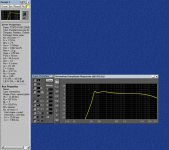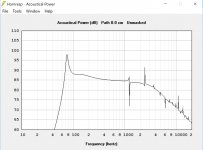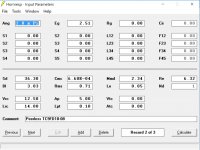Well gents I'm back from China. I was able to give a little presentation at the show and part of the impromptu questions led me to Hornresp. It was very well received. Most people in the loudspeaker industry do not use or even know about this program.
Puzzling. As it is a very robust piece of software.
Here's hoping greater exposure will help out in some way.
Puzzling. As it is a very robust piece of software.
Here's hoping greater exposure will help out in some way.
Hi David,
Just trying out the passive radiator functionality, and it seems to work great. Starting values for PR's T/S parameters can be found in the spec sheets @ Parts Express or Madisound.
I have not spend a lot of time with your help file, and the improvements over the last time I looked are worth the effort to go look, and use it.
Thanks!
Regards,
Just trying out the passive radiator functionality, and it seems to work great. Starting values for PR's T/S parameters can be found in the spec sheets @ Parts Express or Madisound.
I have not spend a lot of time with your help file, and the improvements over the last time I looked are worth the effort to go look, and use it.
Thanks!
Regards,
Here's hoping greater exposure will help out in some way.
Hi Mark,
Welcome back!
Thanks for giving Hornresp a mention during your presentation. I have received emails from China in the past, so at least some people over there are aware of the program
Kind regards,
David
Hi Oliver,
Excellent - thanks for the feedback.
I find that I refer to the Help file quite often myself .
.
Kind regards,
David
Just trying out the passive radiator functionality, and it seems to work great.
Excellent - thanks for the feedback.
I have not spend a lot of time with your help file, and the improvements over the last time I looked are worth the effort to go look, and use it.
I find that I refer to the Help file quite often myself
Kind regards,
David
Last edited:
Hi Mark,
Welcome back!
Thanks for giving Hornresp a mention during your presentation. I have received emails from China in the past, so at least some people over there are aware of the program.
Kind regards,
David
The gents were from all over the world. A few from Denmark, Germany, and America. The head of Eminence was there to. Lot's of great questions.
And a few gents from China.
A good mix.
Brand new to Hornresp, so probably a silly question:
Every time I open the program, an alert pops up and tells me a new version is available, and to my knowledge, I already have it (39.80)... Default behavior, right?
Also: Is there some sort of database with several drivers contained in it?
Just wondering...
Last question: The help file will not open when I click on it, (I use Chrome as my browser). Just this error message:
Thanks in advance for this newbie..
Every time I open the program, an alert pops up and tells me a new version is available, and to my knowledge, I already have it (39.80)... Default behavior, right?
Also: Is there some sort of database with several drivers contained in it?
Just wondering...
Last question: The help file will not open when I click on it, (I use Chrome as my browser). Just this error message:
Is there a way to resolve this?Error opening Help in Windows-based programs: "Feature not included" or "Help not supported"
Thanks in advance for this newbie..
Hmm, no, only when there's a new release, so is it 3980-161007, i.e. Oct. 7, 2016 rev.?
None I'm aware of, just the first [default] file to browse and use to add a new file for you to change as you please.
I use Chrome and never had a problem with opening the HELP file. Not being much of a computer geek, I only know to delete the program and try again in these situations.
GM
None I'm aware of, just the first [default] file to browse and use to add a new file for you to change as you please.
I use Chrome and never had a problem with opening the HELP file. Not being much of a computer geek, I only know to delete the program and try again in these situations.
GM
Also: Is there some sort of database with several drivers contained in it?
Just wondering...
Most manufacturers will provide the data you need.
OK, after some fussing about, and general housekeeping, I am up-to-date with the latest build of 39.80 (161007) Thanks GM.
As to the help files, I have discovered another way to access them, so all is good there.
As to the driver database, I know most manufacturers provide T/S info, I just thought there may be a modern/expanded version of LDSG or Wavecor's site out there ...no biggie..
Thanks for the help guys, very much appreciated.
And thanks to David, this is an awesome program!
As to the help files, I have discovered another way to access them, so all is good there.
As to the driver database, I know most manufacturers provide T/S info, I just thought there may be a modern/expanded version of LDSG or Wavecor's site out there ...no biggie..
Thanks for the help guys, very much appreciated.
And thanks to David, this is an awesome program!
Last question: The help file will not open when I click on it, (I use Chrome as my browser). Just this error message:
Is there a way to resolve this?
The help file is designed to be opened from inside Hornresp, but it's really just a text file with a different extension, so it can be opened in any text editor.
As to the driver database, I know most manufacturers provide T/S info, I just thought there may be a modern/expanded version of LDSG or Wavecor's site out there ...no biggie..
Hi wreckingball,
A driver database can be built in Hornresp, but it requires that the driver parameter values be manually entered first.
See the 'Copy Driver to Database' and 'Paste Driver from Database' entries in the Hornresp Help file for details.
Each driver saved to the Hornresp database has its own text file, meaning that the files are readily transferable. At one stage, there was talk of establishing a central library of driver files that Hornresp users could download as required, but nothing came of it as far as I know.
Kind regards,
David
Well, there is this, but hardly all encompassing and not kept updated like it once was, so kind of dated now: Downloadable WinISD Pro Files - Home Theater Forum and Systems - HomeTheaterShack.com
GM
GM
Well, there is this, but hardly all encompassing and not kept updated like it once was, so kind of dated now: Downloadable WinISD Pro Files - Home Theater Forum and Systems - HomeTheaterShack.com
GM
That becomes the main problem.
The driver data files become dated.
I guess the more active members of this forum could assemble a database.
I have about 60 drivers on file since David made that option possible.
We would need a place to host them and someone to manage the amalgamation of the inputs.
I don't have the time to do that kind of a job.
I don't like the idea of a driver database. If a driver has published specs, specs measured by data-bass and specs measured by 12 different people, which set of specs gets into the database? Who is responsible for making sure that typographical errors are not included when people upload their specs? What happens when someone uploads specs that are different than expected and they don't mention where they came from? What happens when manufacturers change the t/s specs several times for a certain model over the years? Which set of specs should be included and how do you keep track of all that? Enter all the sets of specs by date? How is the end user supposed to choose which is most accurate?
People trust database specs way more than they should. Instead, they should find the specs on their own, enter them on their own, and that way they know where they came from and they are responsible for the accuracy of input.
How hard is it to enter your own measured specs (or do a search and enter specs from a data sheet)?
I've seen measured specs from people that should know what they are doing that are so inaccurate it's unbelievable. Like the famous 800+ grams of moving mass on the SI 18. Putting those obviously erroneous specs into a database is just pure folly.
People should take some responsibility for getting and vetting their own t/s.
People trust database specs way more than they should. Instead, they should find the specs on their own, enter them on their own, and that way they know where they came from and they are responsible for the accuracy of input.
How hard is it to enter your own measured specs (or do a search and enter specs from a data sheet)?
I've seen measured specs from people that should know what they are doing that are so inaccurate it's unbelievable. Like the famous 800+ grams of moving mass on the SI 18. Putting those obviously erroneous specs into a database is just pure folly.
People should take some responsibility for getting and vetting their own t/s.
In the case of the WinISD driver database, the very few t/s I've checked have either been inaccurate or outdated. So it's kind of pointless if you have to confirm the specs you are using are valid.
And what has the WinISD driver database actually done? It's created a generation of people that can't use the program unless the t/s specs are already in the database. If I had a dollar for every thread I've seen asking about how to enter t/s into WinISD I wouldn't have to work. And this persists even though there are detailed instructions in the WinISD help file on how to enter t/s.
A driver database would promote sims done with inaccurate specs and a dumbing down of new end users. That's just my opinion, but I would never use a driver database.
On the other hand, a personally maintained private driver database is a good idea, but we already have that capability.
And what has the WinISD driver database actually done? It's created a generation of people that can't use the program unless the t/s specs are already in the database. If I had a dollar for every thread I've seen asking about how to enter t/s into WinISD I wouldn't have to work. And this persists even though there are detailed instructions in the WinISD help file on how to enter t/s.
A driver database would promote sims done with inaccurate specs and a dumbing down of new end users. That's just my opinion, but I would never use a driver database.
On the other hand, a personally maintained private driver database is a good idea, but we already have that capability.
So, what? Buy the drivers just to know the T/S's? Trust the manufacturer on theirs? (The same set of potential problems you list about a database exist with manufacturers as well..IMO)People trust database specs way more than they should. Instead, they should find the specs on their own
I'll save the rest of my retorts to your comments and just say that my interest in a database was strictly to save time and money (things that all of us have in common, and need to balance).
Example: I bought two SI DS4 18's at closeout price, and have the means to measure T/S's properly.
Someone on the fence about making a purchase at the discounted price may wish to sim them before doing so, I think having the measured info vs the manufacturer's specs could be useful.
Again, my interest in a database is pure economics (and time) based..
My 2 cents
Cheers
*edit* I do not wish to cause any sort of chaos in this thread. I am just stating my opinions, that is all...
Last edited:
I Have just started playing with Hornresp and I hope to call on the knowledge of more experienced users. I have simulated a single driver in a vented box, and the FR graph is not consistent with the manufactures FR, or the simulation I ran with Bassbox. There is a huge dip in HF response in hornresp which is not present in either the manufacturers graphs or the BB simulation with the same driver and boc parameterd. I have attached screen shots from both.
Attachments
Last edited:
The box is simulated as unstuffed, so what you are seeing is the result of internal box reflections. Though Hornresp may exaggerate their severity, they are a real thing. A moderate amount of stuffing should be enough to suppress them into irrelevance.
Try playing with the Lrc and Vrc parameters to see how internal dimensions (for the same volume) influence the result.
Try playing with the Lrc and Vrc parameters to see how internal dimensions (for the same volume) influence the result.
- Home
- Loudspeakers
- Subwoofers
- Hornresp


